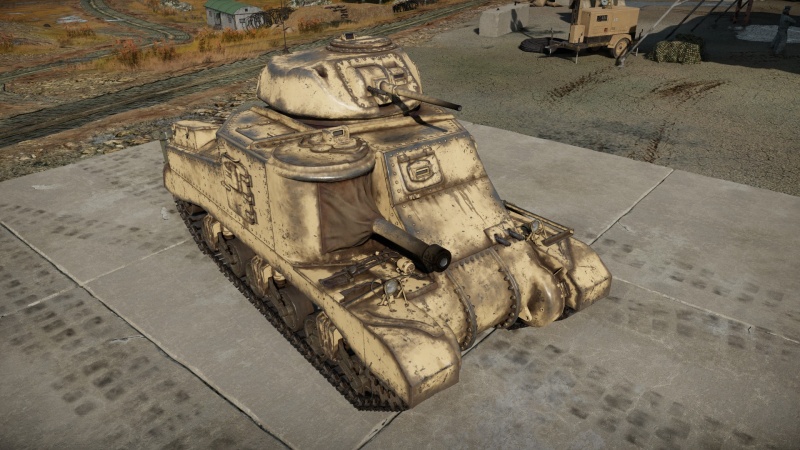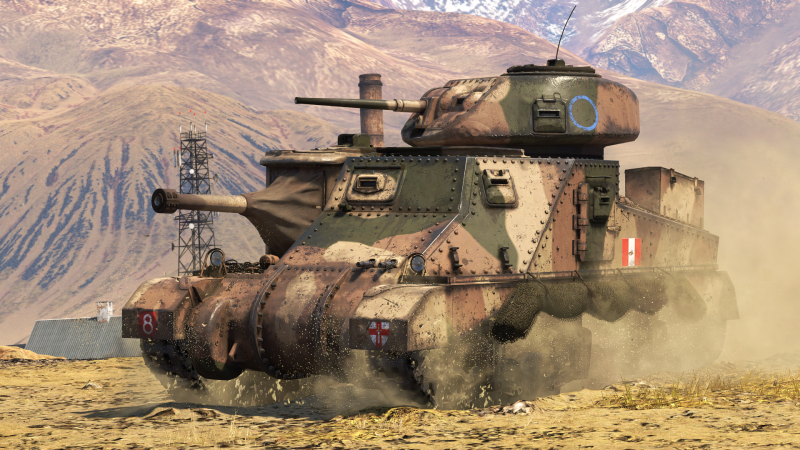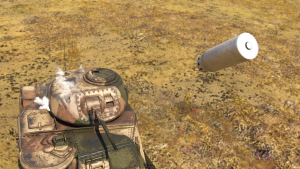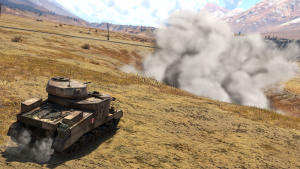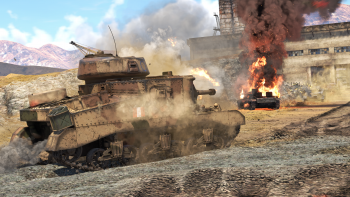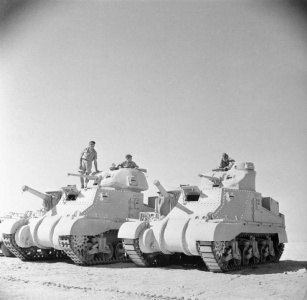Grant I (USA)
| This page is about the gift American medium tank Grant I (USA). For other versions, see M3 Medium (Family). For other uses, see M3 (Disambiguation). |
Contents
Description
Following the defeat in France, the British military was left in a state of equipment shortage and were in need of American equipment to recover from their losses. The premier American medium tank of the time was the M3 medium, however the British sought for modifications to refit the tanks to better suit British needs as well as build from their existing armour experiences. This led to a much larger turret bing developed by Rock Island Arsenal for the British military, with the new turret capable of housing a radio and doing away with the machine gun cupola. In order to distinguish this modified M3 from the regular M3 mediums being purchased from the United States, the modified M3 was given the nickname "Grant" after Ulysses Grant, the 18th President of the United States and a general who commanded the Union Army during the Civil War. The Grants served within the British and Commonwealth military forces, serving both in the European and Pacific Theater.
Introduced in along with the initial American ground tree in Update 1.45 "Steel Generals" as a bundle vehicle, the Grant shared many similarities with the M3 Lee. The redesigned turret brings protection benefits, with the turret front armour being overall thicker than on the M3 Lee. The removal of the machine gun cupola also removes another weak point to prevent enemies from incapacitating the turret crew. Due to the presence of two cannons, this tank is an excellent multi-role vehicle. The Grant can be played it as a brawler combining the agile 37 mm gun with the high damage of the 75 mm gun, but don't get too close, in fact, the turreted gun has a bad depression and, combined with the high profile, tends to make close tanks difficult to hit. Note that the different guns can be assigned different keys to be separately used, so it is possible to select the 75 mm as a primary weapon, allowing the optics to accommodate the 75 mm shells (and not from the point of view of the 37 mm gun) and use the bullet drop indicator in arcade battles. Finally, despite the awkward position of the 75 mm in the hull, it benefits from a stabilization that would allow faster target acquisition when moving in slow speed or coming to a stop.
Although starting as a bundle vehicle, it was later removed from the store. It was reintroduced for War Thunder's 6th Anniversary as a premium purchasable for Golden Eagles ![]() and was made available in the Warbonds shop during Seasons IV and IX of the Battle Pass.
and was made available in the Warbonds shop during Seasons IV and IX of the Battle Pass.
General info
Survivability and armour
Armour type:
- Rolled homogeneous armour (Hull, Turret roof)
- Cast homogeneous armour (Turret, Transmission area)
| Armour | Front (Slope angle) | Sides | Rear | Roof |
|---|---|---|---|---|
| Hull | 38.1 mm (54°) Front Glacis 50.8 mm (15-55°) Transmission area 50.8 mm (30°) Driver port 38.1 mm (0-57°) Hull gun mount |
38.1 mm (0-22°) Top 38.1 mm Bottom |
38.1 mm (1-14°) Top 38.1 mm (15-53°) Bottom |
12.7 mm |
| Turret | 76.2 mm (1-57°) Turret front 38.1 mm (1-69°) Gun mantlet |
50.8 mm (7-45°) | 50.8 mm (1-35°) | 38.1 mm |
| Cupola | 50.8 mm | 50.8 mm | 50.8 mm | 38.1 mm |
Notes:
- Suspension wheels are 15 mm thick, bogies are 10 mm thick, and tracks are 20 mm thick.
- Hull doors and vision ports are 38.1 mm thick.
- Turret ring is 50.8 mm thick.
Mobility
| Game Mode | Max Speed (km/h) | Weight (tons) | Engine power (horsepower) | Power-to-weight ratio (hp/ton) | |||
|---|---|---|---|---|---|---|---|
| Forward | Reverse | Stock | Upgraded | Stock | Upgraded | ||
| Arcade | Expression error: Unexpected * operator. | 620 | Expression error: Unexpected round operator. | __.__ | |||
| Realistic | 354 | Expression error: Unexpected round operator. | __.__ | ||||
Modifications and economy
Armaments
Main armament
| 37 mm M5 | Turret rotation speed (°/s) | Reloading rate (seconds) | |||||||||||
|---|---|---|---|---|---|---|---|---|---|---|---|---|---|
| Mode | Capacity | Vertical | Horizontal | Stabilizer | Stock | Upgraded | Full | Expert | Aced | Stock | Full | Expert | Aced |
| Arcade | 128 | -7°/+60° | ±180° | N/A | 17.1 | 23.7 | 28.8 | 31.8 | 33.9 | 3.77 | 3.33 | 3.07 | 2.90 |
| Realistic | 10.7 | 12.6 | 15.3 | 16.9 | 18.0 | ||||||||
Ammunition
| Penetration statistics | |||||||
|---|---|---|---|---|---|---|---|
| Ammunition | Type of warhead |
Penetration @ 0° Angle of Attack (mm) | |||||
| 10 m | 100 m | 500 m | 1,000 m | 1,500 m | 2,000 m | ||
| M74B1 | AP | 79 | 76 | 65 | 54 | 45 | 37 |
| M51B1 | APCBC | 87 | 84 | 73 | 60 | 50 | 41 |
| Shell details | ||||||||||||
|---|---|---|---|---|---|---|---|---|---|---|---|---|
| Ammunition | Type of warhead |
Velocity (m/s) |
Projectile mass (kg) |
Fuse delay | Fuse sensitivity (mm) |
Explosive mass (TNT equivalent) (g) |
Ricochet | |||||
| 0% | 50% | 100% | ||||||||||
| M74B1 | AP | 883 | 0.87 | - | - | - | 47° | 60° | 65° | |||
| M51B1 | APCBC | 883 | 0.87 | - | - | - | 48° | 63° | 71° | |||
Ammo racks
| Full ammo |
1st rack empty |
2nd rack empty |
3rd rack empty |
4th rack empty |
5th rack empty |
6th rack empty |
7th rack empty |
8th rack empty |
9th rack empty |
Visual discrepancy |
|---|---|---|---|---|---|---|---|---|---|---|
| 128 | 125 (+3) | 121 (+7) | 117 (+11) | 97 (+31) | 74 (+54) | 70 (+58) | 57 (+71) | 27 (+101) | 1 (+127) | Yes |
Additional armament
| 75 mm M2 | Turret rotation speed (°/s) | Reloading rate (seconds) | |||||||||||
|---|---|---|---|---|---|---|---|---|---|---|---|---|---|
| Mode | Capacity | Vertical | Horizontal | Stabilizer | Stock | Upgraded | Full | Expert | Aced | Stock | Full | Expert | Aced |
| Arcade | 65 | -9°/+20° | ±15° | Vertical | 11 | 16 | 19 | 21 | 23 | 6.2 | 5.5 | 5.0 | 4.8 |
| Realistic | 7.1 | 8.4 | 10 | 11 | 12 | ||||||||
Ammunition
| Penetration statistics | |||||||
|---|---|---|---|---|---|---|---|
| Ammunition | Type of warhead |
Penetration @ 0° Angle of Attack (mm) | |||||
| 10 m | 100 m | 500 m | 1,000 m | 1,500 m | 2,000 m | ||
| M48 shell | HE | 10 | 10 | 10 | 10 | 10 | 10 |
| M72 shot | AP | 84 | 82 | 73 | 62 | 53 | 46 |
| M61 shot | APCBC | 97 | 95 | 87 | 78 | 70 | 63 |
| Shell details | ||||||||||||
|---|---|---|---|---|---|---|---|---|---|---|---|---|
| Ammunition | Type of warhead |
Velocity (m/s) |
Projectile mass (kg) |
Fuse delay (m) |
Fuse sensitivity (mm) |
Explosive mass (TNT equivalent) (g) |
Ricochet | |||||
| 0% | 50% | 100% | ||||||||||
| M48 shell | HE | 448 | 6.3 | 0.2 | 0.1 | 666 | 79° | 80° | 81° | |||
| M72 shot | AP | 588 | 6.3 | - | - | - | 47° | 60° | 65° | |||
| M61 shot | APCBC | 588 | 6.79 | 1.2 | 14 | 63.7 | 48° | 63° | 71° | |||
| Smoke shell characteristics | ||||||
|---|---|---|---|---|---|---|
| Ammunition | Velocity (m/s) |
Projectile mass (kg) |
Screen radius (m) |
Screen deploy time (s) |
Screen hold time (s) |
Explosive mass (TNT equivalent) (g) |
| M89 | 259 | 3 | 9 | 5 | 20 | 50 |
Ammo racks
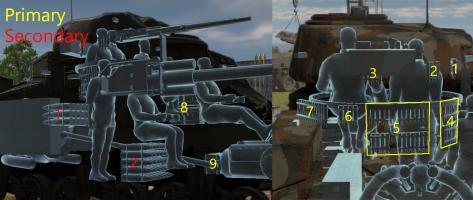
| Full ammo |
1st rack empty |
2nd rack empty |
Visual discrepancy |
|---|---|---|---|
| 65 | 36 (+29) | 1 (+64) | Yes |
Machine guns
| 7.62 mm M1919A4 | ||||
|---|---|---|---|---|
| Mount | Capacity (Belt) | Fire rate | Vertical | Horizontal |
| Coaxial | 4,000 (250) | 500 | N/A | N/A |
Usage in battles
The multiple cannons allow for different combinations of attack. The 75 mm gun possesses armour penetration on about the level of the 37 mm gun; however, the damage upon penetration is extremely high with the M61 APCBC shell due to the HE filler. On the other hand, the 37 mm gun allows for close quarters and longer-range fighting, where its high-velocity and effective shell make for good long range targeting while it is also the only cannon on the Grant that has a full 360-degree traverse.
Different guns mean different styles of play. The Grant can be played as a tank destroyer, using its sponson gun to take shots at medium range and its 37 mm to cover the flanks and make longer range snipe shots. The Grant can also be used as an assault tank, quickly advancing on points while switching between the powerful 75 mm gun and the faster-firing 37 mm. In all game modes, the two gun profiles should be assigned to different keys, this will allow players to aim using the sights of the three guns separately, allowing the usage of the individual optics to actually hit things at range.
the Grant I has the possibility of facing long-barrelled Pz.Kpfw. III, and Pz.Kpfw. IV, as well as T-34s. The ZiS-30 and Na-To are also very deadly. The 75 mm gun can reliable penetrate all of these tanks at short range (save the T-34), whereas the 37 mm will require some particular shot placement.
Pros and cons
Pros:
- Ability to use two guns: a 37 mm and a 75 mm - which is very powerful at this rank
- Fine frontal armour
- Side mounted 75 mm gives the ability for some unique tactics
- Despite the tall profile, the "wedding cake" design of the turret has thick sloped armour, providing extra protection to make up for its height
Cons:
- Tall profile, big target
- Fixed 75 mm gun in the sponson makes it harder to use as a primary
- Slow traverse speeds make it easy for a light or a particularly speedy medium tank to sneak around the sides
- The 37 mm gun does not have a stabilizer unlike the regular M3 variant
History
Development
After the development of the M2 medium tank, the Battle of France showed that such a tank was not going to be capable to go up against the German Panzer IIIs and Panzer IVs. With the Western Allies now embroiled in the North African campaign against the Germans and Italians, the Allies needed a good tank capable of going against the Panzer tanks, and they needed it quickly.
The M3 Lee tank started from the basis of the M2 Medium Tank, using the chassis and the VVSS suspension system. It was to mount the 75 mm cannon, however it was discovered that the United States does not have a turret design that could mount the 75 mm gun. So as development on the turret proceeded, the 75 mm on the M3 would be sponson-mounted. This design was tested on the M2 medium tank as the T5E2, which was approved for the M3 design. The M3 featured a medium tank with two guns, the 75 mm on the hull sponson mount, and a 37 mm with a coaxial machine gun on a turret. The turret cupola also had its own machine gun and there were also two fixed bow machine guns. The use of two gun mounts on a tank was similar to the German Neubaufahrzeug and Soviet T-35 tanks. The M3's 75 mm gun however presented a huge advantage over contemporary tank armaments, as the 75 mm could fire high-explosive rounds for against infantry and anti-tank guns, yet could also fire a shell with a high enough velocity for anti-tank purposes.
The M3's faults were the high profile and the sponson mount for its main armament. The M3 was 10 ft. 3 in. tall, a feet taller than the M2 medium tank. The 75 mm on a sponson mount meant that the main armament of the tank had a limited traverse compared to a rotatable turret and forced the tank to reveal much of its body in order to aim the gun at the enemy. The M3 was also constructed out of rivets (which increased spalling) and had a smooth track design which reduced ground traction. Despite these disadvantages, the British happily accepted them as they were critically low on tanks. German Colonel Hans von Luck said he even considered them superior to the Panzer IVs.
The M3 first saw service with the British in the campaign for North Africa beginning in May, 1942. Those that had been made with a British-designed turret were identified as "Grant", whereas an additional quantity that were Lend-Leased to the British later on with the standard U.S turret were named "Lee." The British cast turret on the Grant was considered superior in terms of frontal protection and replaced the American smoke dischargers with a British smoke mortar, but did not have the cupola or cupola MG of the Lee. The Grant also moved the radio into the turret, removing the need for a separate radio operator position in the hull (the Americans would later do this with their M3s as well). Their baptism of fire was the Gazala battles, where 167 Grants were present with 1st and 7th Armoured Divisions. Regiments with Grants were initially organized on a 2:1 Grants-to-Stuarts, or a 2:1 Crusaders-to-Grants basis, but by 2nd Alamein in October, 1942, Shermans had also been added into that mix. Still, over 170 Grants or Lees were in the line for that battle. There were 3 tanks in a Grant/Lee troop. By May, 1943, all British Grants and Lees were replaced with newer tanks, mostly the Sherman.
Production on the Lee had begun in August 1941. A majority of these were completed at Baldwin Locomotive Works in Philadelphia, Pennsylvania. The British would receive more than their original order of 1,250 tanks. Of the total 6,258 M3s built by the US between start up to the end of production in December 1942, 2,855 units (over 1,600 Grants, and over 1,200 Lees) went to the British and 1,386 Lees went to the Soviet Union, were they served until 1943 before being replaced. A mix of Grants ahd Lees were also used by the Australians and Indians in the India-Burma theater, beginning in December, 1943, serving there until the end of the war with Japan. The M3 risked causing confusion in British service as the same "M3" designation was given to the M3 Light Tank. This set off their tradition of naming American-made tanks after generals, where the M3 medium tank earned the name M3 Lee for the American-turret variant (Grant for the British variant) and the M3 light tank was called the Stuart. Americans did not use these names themselves, only starting to name their tanks after the war.
Combat usage
Combat experience with the M3 Lee was complicated but favourable. In Africa, the Lees and Grants in British and American service surprised the German forces when they could withstand the 50 mm KwK 38 L/42 gun and 75 mm KwK 37 L/24 howitzer armament on the Panzer IIIs and Panzer IVs. The M3 Lee proved reliable and adequate in armour protection. The Soviet's experience with the M3 Lee was less favourable, as their T-34 tanks were much better in combat performance. The Soviets euphemistically called it a "grave for six men" and the Lee tanks were relegated to the secondary fronts or repurposed as armoured personnel carriers. In the Pacific, the M3 Lees were lent to the Australians and Indians, which proved vastly superior to the Japanese tanks in service. The only American use of the M3 Lee at the Pacific Theater was during the Battle of Makin Island.
The M3 Lee served fine as a stop-gap solution for the American tank development. They performed very well on the combat field and proved very reliable. However, once a 75 mm turret was finally designed, the M3 Lee was redesigned to use it, and the resulting tank was the M4 Sherman, which will go on to replace the M3 tanks in the Allies as they are withdrawn from service. Even if it wasn't, the M3 was becoming obsolete due to newer German tanks being deployed, such as the Panther, Tiger I, or improvement of old chassis like Panzer IV Ausf. G and StuG III Ausf. F. Its obsolescence was a consequence of its own rather unique development and anachronistic design, limiting this medium tank's service life to a mere two years in Allied hands. However, it lived on until the end of WW2 in some modifications such as tractor and recovery vehicle. The chassis and running gear were adapted by the Canadians to develop their Ram medium tank.
An anecdote
- "The 75 (mm gun) is firing. The 37 (mm gun) is firing, but it is traversed around the wrong way. The Browning (machine gun) is jammed. I am saying 'Driver advance' on the A set and the driver, who can't hear me, is reversing. And as I look over the top of the turret and see twelve enemy tanks fifty yards away, someone hands me a cheese sandwich." —British Lieutenant Ken Giles, tank commander of a M3 Grant[1]
| Archive of the in-game description | |
|---|---|
|
The bitter taste left in the mouth of British builders after battles in Greece and France forced them to take a hard look at the future of their armour. They did not have a single powerful artillery system of their own, though the US at the time had just begun producing their new M3 Lee and its sponson-mounted 75 mm cannon. After evaluating the American-made M3, the British decided that it would primarily be used in North Africa. A major invasion was planned for 1941, and so the Americans were asked to develop a new and elongated cast turret with a bustle at the back for a British Wireless Set No. 19. Periscopes were added on each side closer to the back in addition to slots from which to fire personal weapons. The cupola was unneeded and removed, being replaced by a short addition with a folding hatch in front of an antenna output. In total, the turret became 30 mm shorter, reducing the tank's profile. The M3 modification for the British was designated the Grant Mk I. The first contracts with Baldwin, Lima, and Pullman were signed at the end of 1940, with deliveries totaling 1,685 units beginning six months later. The Grant Mk I saw action in North Africa from 1942 to 1943 with varying success. Crew members reported that the German Pz.II and Pz.III tanks shot their armour-piercing shells from a distance of 1,100 meters. The Mk I was not as manoeuvrable as its German counterparts, and its side armour could not sustain hits from 50 mm tank cannons. Further, 88 mm anti-tank guns easily pierced its armour, while the high silhouette made long-range targeting easier. The British Grant Mk Is saw limited action in the 1943 invasion of Sicily. | |
Media
- Skins
- Images
The M3 Lee (right) and M3 Grant in the North Africa Theater.
- Videos
See also
- Related development
External links
References
- ↑ Bell, Chris. "Fury: All You Need to Know about Life in a Tank." The Telegraph. Telegraph Media Group, 24 Oct. 2014. Web. 12 Jan. 2017. <http://www.telegraph.co.uk/culture/film/film-news/11167575/Fury-all-you-need-to-know-about-life-in-a-tank.html>
| USA medium tanks | |
|---|---|
| M2 | M2 |
| M3 | M3 Lee · ▃Grant I |
| M4 | M4 · Calliope · M4A1 · M4A1 (76) W · M4A2 · M4A2 (76) W · M4A3 (105) · M4A3 (76) W · M4/T26 |
| M26 Pershing | T20 · T25 · M26 · M26 T99 · M26E1 |
| M46/47/48 Patton | M46 · M46 "Tiger" · M47 · M48A1 · T54E1 · T54E2 |
| M60 | M60 · M60A1 (AOS) · M60A1 RISE (P) · M60A2 · M60A3 TTS · M728 CEV · 120S |
| MBT-70 | MBT-70 · XM803 |
| M1 Abrams | XM1 (Chrysler) · XM1 (GM) |
| M1 Abrams · M1 KVT · IPM1 | |
| M1A1 · M1A1 HC · M1A1 Click-Bait | |
| M1A2 Abrams · M1A2 SEP · M1A2 SEP V2 | |
| Other | T95E1 |
| Australia | M1A1 AIM |
| Canada | M4A5 |
| Israel | ▃Magach 3 (ERA) · ▃Merkava Mk.1 · ▃Merkava Mk.2B · ▃Merkava Mk.3D |
| Turkey | M60 AMBT |
| USA premium ground vehicles | |
|---|---|
| Light tanks | LVT(A)(4) · M2A4 (1st Arm.Div.) · M3A1 (USMC) · ▃Stuart VI (5th CAD) · M8 LAC · M8A1 GMC |
| M18 "Black Cat" · Super Hellcat · T18E2 · M551(76) · T114 · M1128 Wolfpack | |
| Medium tanks | ▃Grant I · M4A5 · Calliope · T20 · M26 T99 · M26E1 · M46 "Tiger" · T54E1 · T54E2 · ▃Magach 3 (ERA) · M728 CEV |
| XM1 (GM) · XM1 (Chrysler) · M1 KVT · M1A1 Click-Bait | |
| Heavy tanks | T14 · Cobra King · M6A2E1 · T29 · T30 |
| Tank destroyers | T28 · T55E1 |



